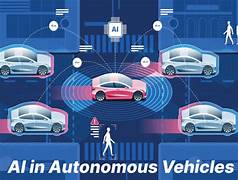AI in Autonomous Vehicle Platooning for Traffic Efficiency
As cities expand and global transportation networks become increasingly complex, traffic congestion has emerged as a major challenge, causing delays, economic losses, and environmental harm. Autonomous Vehicle (AV) platooning, powered by Artificial Intelligence (AI), offers a promising solution to this problem. By enabling vehicles to travel in tightly coordinated groups, AV platooning can improve traffic efficiency, reduce fuel consumption, and enhance road safety.
This article explores the concept of autonomous vehicle platooning, the role of AI in its implementation, its benefits, real-world applications, challenges, and the future of this revolutionary technology.
What is Autonomous Vehicle Platooning?
Autonomous Vehicle Platooning refers to a group of vehicles traveling together in a coordinated manner with minimal gaps between them. These vehicles, often led by a single manually driven or autonomous lead vehicle, communicate wirelessly to synchronize their movements. AI plays a pivotal role in ensuring seamless coordination, real-time decision-making, and adaptive responses to dynamic road conditions.
Platooning is primarily designed for highways, where traffic flows at higher speeds and lane changes are less frequent. However, its potential applications extend to urban and intercity traffic as well.
How AI Powers Autonomous Vehicle Platooning
AI is the backbone of autonomous vehicle platooning, enabling real-time data analysis, decision-making, and coordination. Below are the key components of AI-driven platooning:
1. Vehicle-to-Vehicle (V2V) Communication
AI algorithms process information exchanged between vehicles in a platoon through V2V communication. This includes data on speed, position, acceleration, and braking. AI ensures the vehicles maintain optimal distances and respond to changes in real time.
2. Adaptive Cruise Control (ACC)
ACC systems powered by AI enable vehicles to adjust their speed automatically based on the lead vehicle and surrounding traffic. AI ensures smooth acceleration and deceleration, maintaining consistency across the platoon.
3. Sensor Fusion
AI combines data from multiple sensors, including radar, LiDAR, cameras, and GPS, to create a comprehensive understanding of the environment. This allows vehicles to detect obstacles, anticipate lane changes, and adapt to road conditions.
4. Machine Learning (ML) Algorithms
ML models are trained on vast datasets to predict traffic patterns, recognize potential hazards, and optimize vehicle behavior. These models continuously learn and improve through real-world experiences, making platooning safer and more efficient.
5. Real-Time Decision-Making
AI systems process incoming data at high speeds, enabling vehicles to make split-second decisions. This is crucial for maintaining safe distances, coordinating lane changes, and responding to emergencies.
6. Predictive Analytics
AI anticipates the behavior of other road users, such as merging traffic or sudden stops, allowing the platoon to adjust proactively rather than reactively.
Benefits of AI-Driven Autonomous Vehicle Platooning
The integration of AI in vehicle platooning offers numerous benefits across various dimensions:
1. Enhanced Traffic Efficiency
Platooning reduces the space between vehicles, increasing road capacity and allowing more vehicles to travel efficiently. AI ensures that traffic flows smoothly by minimizing unnecessary braking and acceleration.
2. Fuel Savings and Reduced Emissions
By maintaining consistent speeds and reducing air resistance through drafting, vehicles in a platoon consume less fuel. Studies show fuel savings of up to 10-20% for trailing vehicles, contributing to lower greenhouse gas emissions.
3. Improved Road Safety
AI-driven platooning reduces the likelihood of human errors, such as sudden braking or lane drifting. Coordinated braking and acceleration minimize the risk of collisions within the platoon.
4. Reduced Driver Fatigue
For commercial drivers, platooning reduces the cognitive load by automating many aspects of driving. This can lead to fewer accidents caused by driver fatigue.
5. Cost Efficiency
In logistics, platooning reduces operational costs by optimizing fuel consumption and improving delivery times. It also minimizes vehicle wear and tear due to smoother driving patterns.
6. Scalability for Urban Mobility
In urban settings, AI-powered platooning can optimize bus and shuttle services, reducing congestion during peak hours and enhancing public transportation efficiency.
Real-World Applications of AI-Driven Platooning
1. Freight Transportation
Truck platooning is one of the most promising applications of AI in autonomous vehicle technology. Logistics companies use platooning to streamline freight delivery, reduce fuel costs, and improve route efficiency.
2. Public Transportation
In urban areas, buses equipped with platooning technology can travel in synchronized groups, reducing traffic congestion and improving the reliability of public transit schedules.
3. Highway Travel
Platooning on highways enables private vehicles to travel efficiently in groups, reducing commute times and improving overall traffic flow.
4. Emergency and Military Applications
Platooning can be utilized in emergency response scenarios to deploy vehicles in a coordinated manner. It also has potential applications in military logistics, where convoy safety and efficiency are paramount.
5. Ride-Sharing Services
Autonomous ride-sharing vehicles can form platoons during peak hours, reducing congestion and ensuring smoother passenger experiences.
Challenges in Implementing AI-Driven Platooning
Despite its potential, AI-driven platooning faces several challenges:
1. Technological Complexity
Platooning requires seamless integration of AI algorithms, V2V communication, and sensor technologies. Ensuring real-time data processing and decision-making at high speeds is a significant technical challenge.
2. Regulatory and Legal Barriers
Regulations governing autonomous vehicles and platooning vary widely across regions. Legal frameworks must be updated to address issues such as liability in case of accidents.
3. Interoperability
Vehicles from different manufacturers must be able to communicate and coordinate effectively. Developing standardized protocols for platooning is critical for widespread adoption.
4. Cybersecurity Risks
V2V communication systems are vulnerable to cyberattacks, which could disrupt platooning operations or compromise safety. Robust AI-driven cybersecurity measures are essential to mitigate these risks.
5. Weather and Environmental Conditions
Adverse weather conditions, such as heavy rain, snow, or fog, can affect sensor performance and reduce the accuracy of AI systems. Developing robust AI models that can handle such conditions is a key area of research.
6. Public Acceptance
Widespread adoption of platooning requires public trust in AI and autonomous vehicle technologies. Addressing safety concerns and demonstrating the reliability of these systems is crucial.
Future Prospects of AI-Driven Platooning
The future of AI in autonomous vehicle platooning looks promising, with advancements in several areas:
1. Integration with Smart Infrastructure
Platooning systems will benefit from integration with smart city infrastructure, such as connected traffic lights and real-time traffic monitoring systems, to optimize routes and improve efficiency.
2. Enhanced AI Algorithms
AI models will become more sophisticated, enabling better prediction of traffic patterns, improved decision-making, and safer interactions with other road users.
3. Greater Adoption in Public Transportation
As urban populations grow, cities will increasingly adopt platooning technology to enhance public transportation efficiency and reduce congestion.
4. Expansion of V2X Communication
The evolution of Vehicle-to-Everything (V2X) communication will enable platooning systems to interact with pedestrians, cyclists, and infrastructure, creating a more holistic traffic management ecosystem.
5. Electric and Sustainable Mobility
Platooning technology will complement the shift to electric vehicles, optimizing their energy consumption and contributing to sustainable transportation networks.
6. Collaboration with Autonomous Driving
Platooning will play a pivotal role in the broader adoption of fully autonomous vehicles, creating safer and more efficient transportation systems.
Conclusion
AI-driven autonomous vehicle platooning represents a significant step forward in addressing the challenges of traffic congestion, fuel inefficiency, and road safety. By leveraging advanced AI technologies such as machine learning, sensor fusion, and V2V communication, platooning systems enable vehicles to operate in tightly coordinated groups, enhancing traffic efficiency and reducing environmental impact.
While challenges such as technological complexity, regulatory barriers, and cybersecurity risks remain, ongoing advancements in AI and collaborative efforts between governments, manufacturers, and technology providers promise to overcome these hurdles. As the transportation landscape evolves, AI-powered platooning will play a central role in shaping a safer, more efficient, and sustainable future for mobility.


